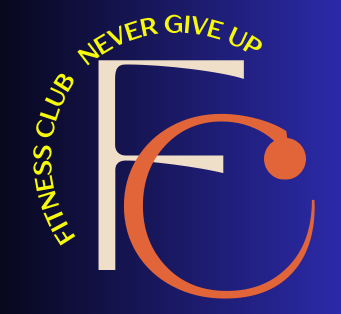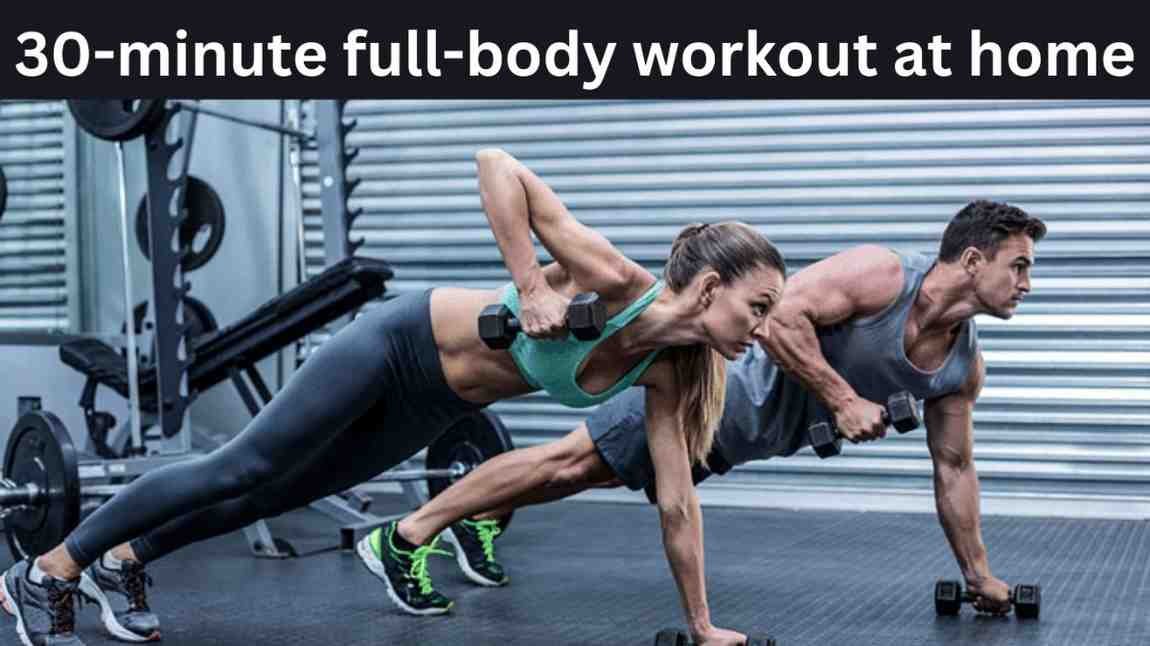In today’s fast-paced world, finding time to hit the gym can be a challenge. But who says you need fancy equipment or a gym membership to get in a great workout? With this 30-minute full-body workout that you can do at home, you’ll be able to sculpt and strengthen your entire body without ever leaving the comfort of your living room. Whether you’re short on time or just prefer the convenience of working out at home, this routine is perfect for you.
Before we jump into the workout, it’s important to warm up your muscles to prevent injury and prepare your body for the exercises ahead. Spend 5-10 minutes doing dynamic stretches such as arm circles, leg swings, and torso twists. You can also add in some light cardio like jogging in place or jumping jacks to get your heart rate up.
Once you’re warmed up and ready to go, grab a yoga mat or towel and clear some space in your living room. This workout consists of six exercises, each targeting different muscle groups to give you a comprehensive full-body burn. Perform each exercise for 45 seconds, followed by a 15-second rest. Complete three rounds total for a total workout time of just 30 minutes.
Squats:
Squats are a fundamental lower body exercise that targets multiple muscle groups, including the quadriceps, hamstrings, glutes, and calves. They are a compound movement, meaning they engage more than one joint and muscle group at a time, making them highly efficient for building strength and muscle mass.
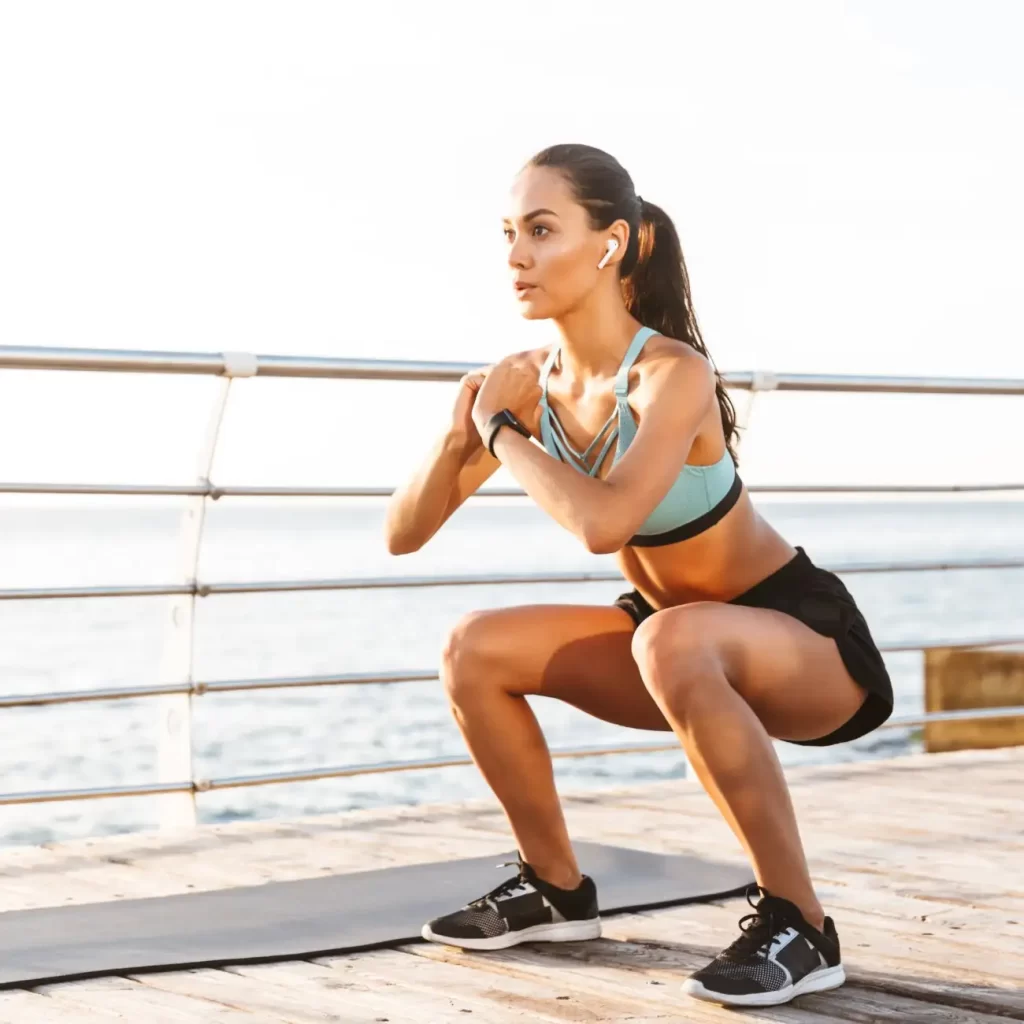
To perform a squat:
- Stand with your feet shoulder-width apart, toes pointing slightly outward for comfort and stability.
- Keep your chest up, shoulders back, and core engaged to maintain good posture throughout the movement.
- Initiate the movement by pushing your hips back as if you’re sitting back into a chair.
- Lower your body down by bending your knees, keeping them in line with your toes and tracking over your ankles.
- Aim to lower down until your thighs are parallel to the ground, or as low as you can comfortably go while maintaining good form.
- Press through your heels and engage your glutes to drive back up to the starting position, fully extending your hips at the top.
- Squeeze your glutes at the top of the movement to ensure full hip extension.
- Repeat for the desired number of repetitions.
Common mistakes to avoid when performing squats include allowing your knees to collapse inward, rounding your lower back, or leaning too far forward, which can put unnecessary strain on your joints and lower back. Focus on keeping your weight centered over your midfoot and maintaining a neutral spine throughout the movement.
Squats can be modified to suit different fitness levels and goals. Beginners may start with bodyweight squats or use a chair or bench for added support. As you become more advanced, you can progress to using weights such as dumbbells, barbells, or kettlebells to increase the intensity of the exercise.
Incorporating squats into your workout routine can help improve overall lower body strength, functional movement patterns, and athletic performance. Whether your goal is to build muscle, increase power, or improve mobility, squats are an essential exercise for any fitness regimen.
Push-Ups:
Push-ups are a classic bodyweight exercise that primarily targets the muscles of the chest, shoulders, and triceps, while also engaging the core and stabilizing muscles throughout the body. They are versatile exercises that can be performed virtually anywhere and can be easily modified to suit different fitness levels.
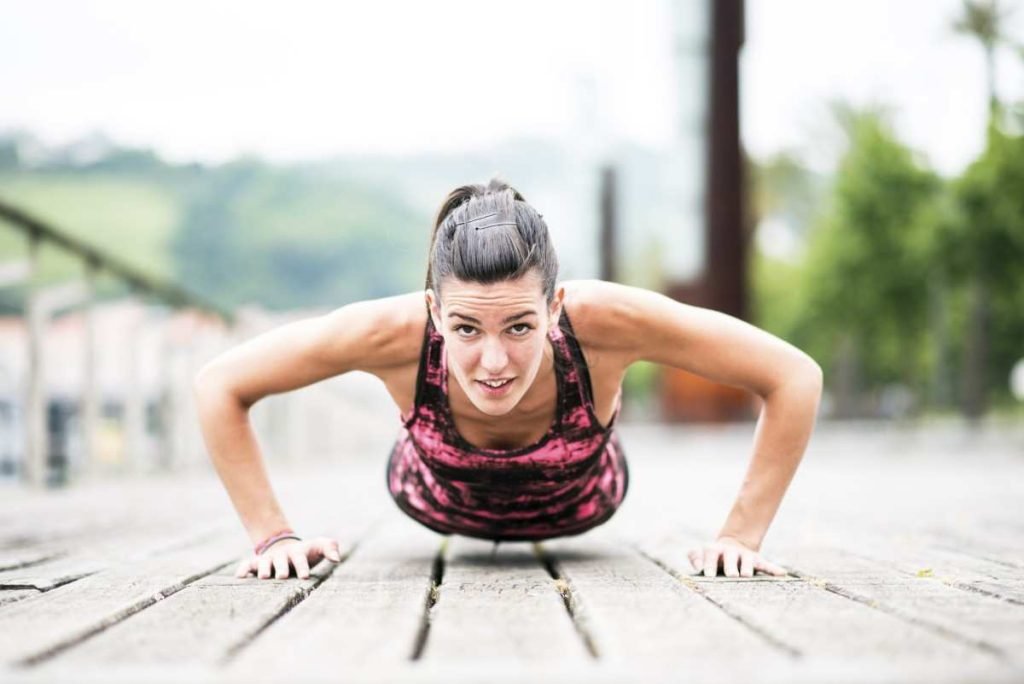
To perform a standard push-up:
- Start in a high plank position with your hands placed slightly wider than shoulder-width apart, fingers pointing forward or slightly turned out.
- Keep your body in a straight line from head to heels, with your core engaged and your glutes squeezed.
- Lower your body towards the ground by bending your elbows, keeping them close to your body at a 45-degree angle.
- Lower down until your chest nearly touches the ground, or as low as you can go while maintaining good form.
- Push through your palms to straighten your arms and return to the starting position, fully extending your elbows at the top.
- Keep your core engaged throughout the movement to prevent your hips from sagging or lifting.
- Repeat for the desired number of repetitions.
Common mistakes to avoid when performing push-ups include allowing your hips to sag or lift, flaring your elbows out to the sides, or only partially lowering your body toward the ground. Focus on maintaining a straight line from head to heels and lowering your chest down towards the ground with control.
Push-ups can be modified to make them easier or more challenging based on your fitness level:
Knee Push-Ups:
Start in a high plank position with your knees on the ground, rather than your toes. This reduces the amount of body weight you’re lifting and makes the exercise easier.
Incline Push-Ups:
Perform push-ups with your hands elevated on a stable surface, such as a bench, chair, or countertop. This reduces the amount of weight on your upper body, making the exercise easier.
Decline Push-Ups:
Perform push-ups with your feet elevated on a stable surface, such as a bench or step. This increases the amount of weight on your upper body, making the exercise more challenging.
Hand Placement Variations:
Adjust the width of your hand placement to target different muscle groups. A wider hand placement targets the chest more, while a narrower hand placement targets the triceps more.
Incorporating push-ups into your workout routine can help improve upper body strength, muscular endurance, and core stability. Whether you’re a beginner looking to build foundational strength or an advanced athlete aiming to challenge yourself, push-ups are a versatile exercise that can help you reach your fitness goals.
Lunges:
Lunges are a fantastic lower body exercise that targets the quadriceps, hamstrings, glutes, and calves, while also engaging the core for stability and balance. They are unilateral exercises, meaning they work one leg at a time, which helps to correct muscle imbalances and improve functional strength.
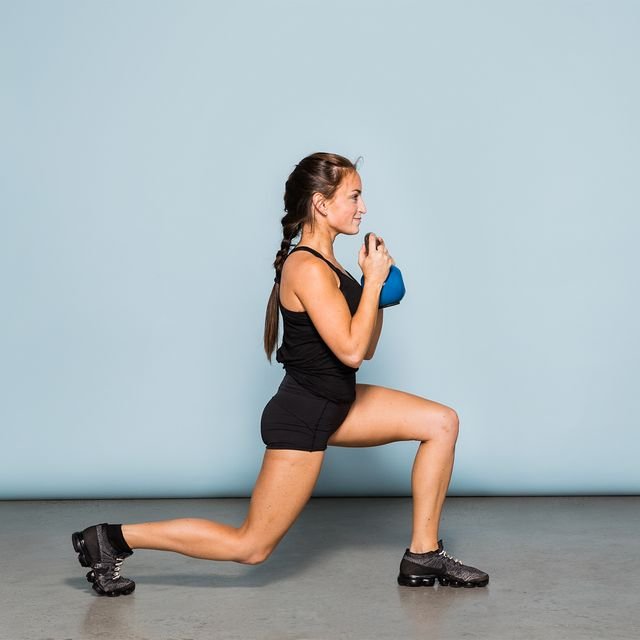
To perform a basic forward lunge:
- Start standing with your feet hip-width apart and your hands on your hips or by your sides for balance.
- Take a big step forward with your right foot, landing heel first.
- Lower your body down until both knees are bent at a 90-degree angle, with your front thigh parallel to the ground and your back knee hovering just above the floor.
- Ensure your front knee is directly above your ankle and does not extend past your toes.
- Keep your torso upright and your chest lifted throughout the movement.
- Push through your right heel to return to the starting position, engaging your glutes and quadriceps.
- Repeat on the left side, alternating legs for the desired number of repetitions.
To perform reverse lunges:
- Begin standing with your feet hip-width apart and your hands on your hips or by your sides.
- Take a big step back with your right foot, landing on the ball of your foot.
- Lower your body down until both knees are bent at a 90-degree angle, with your front thigh parallel to the ground and your back knee hovering just above the floor.
- Keep your torso upright and your chest lifted throughout the movement.
- Push through your left heel to return to the starting position, engaging your glutes and quadriceps.
- Repeat on the left side, alternating legs for the desired number of repetitions.
Common mistakes to avoid when performing lunges include allowing your front knee to collapse inward, leaning too far forward or backward, or allowing your front heel to lift off the ground. Focus on maintaining proper alignment and control throughout the movement to maximize the effectiveness of the exercise and reduce the risk of injury.
Lunges can be modified to suit different fitness levels and goals:
- Stationary Lunges: Perform lunges without stepping forward or backward, simply lowering your body straight down and then returning to the starting position.
- Walking Lunges: Perform lunges while walking forward, alternating legs with each step.
- Weighted Lunges: Hold dumbbells or kettlebells in each hand to increase the resistance and challenge of the exercise.
- Pulse Lunges: Add a pulsing motion at the bottom of the lunge to increase time under tension and target the muscles even more intensely.
Incorporating lunges into your workout routine can help improve lower body strength, balance, and stability, while also enhancing functional movement patterns for activities of daily living. Whether you’re a beginner looking to build strength or an advanced athlete aiming to increase power and agility, lunges are a versatile exercise that can benefit individuals of all fitness levels.
Plank:
The plank is a fundamental core-strengthening exercise that also engages the muscles of the shoulders, chest, back, and glutes. It’s an isometric exercise, meaning you hold a static position for an extended period, which helps to improve core stability, posture, and overall strength.
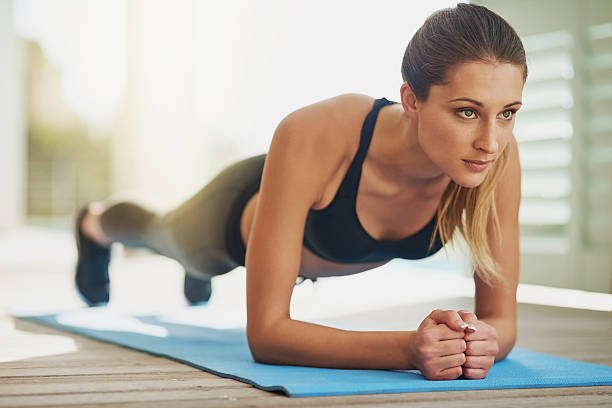
To perform a standard plank:
- Begin by positioning yourself face down on the floor, resting on your forearms and toes.
- Elbows should be directly beneath your shoulders, with your forearms parallel to each other, and your hands flat on the ground.
- Engage your core muscles and lift your body off the ground, forming a straight line from your head to your heels.
- Keep your neck in line with your spine, avoiding any sagging or lifting of the hips.
- Engage your glutes and thighs to help support your bodyweight and maintain stability.
- Hold this position for the desired duration, aiming to keep your body in a straight line without allowing your hips to drop or your lower back to arch excessively.
- Breathe deeply and evenly throughout the exercise, focusing on maintaining proper form and engaging the muscles of your core.
Common mistakes to avoid when performing the plank include:
- Sagging Hips:
- Ensure your body forms a straight line from head to heels, avoiding any drooping or lifting of the hips.
- Arching Lower Back:
- Keep your core muscles engaged to prevent your lower back from sagging towards the floor.
- Dropping Head:
- Maintain a neutral spine by keeping your head in line with your body, avoiding any excessive strain on your neck.
- Holding Breath:
- Remember to breathe steadily throughout the exercise, inhaling and exhaling deeply to maintain oxygen flow to your muscles.
Planks can be modified to suit different fitness levels and goals:
- Forearm Plank: The standard plank position described above, with your weight supported on your forearms instead of your hands.
- High Plank: Similar to a push-up position, with your weight supported on your hands, arms fully extended, and wrists directly beneath your shoulders.
- Side Plank: Rotate your body to one side, supporting your weight on one forearm or hand and the side of your foot. Keep your body in a straight line from head to heels, engaging the oblique muscles on the side of your body facing upwards.
- Plank Variations: Add movement or instability to challenge your core even further, such as plank jacks, plank shoulder taps, or plank with knee drives.
Incorporating planks into your workout routine can help improve core strength, stability, and posture, which are essential for overall health and functional movement. Whether you’re a beginner looking to build foundational strength or an advanced athlete aiming to increase core endurance, planks are a versatile exercise that can benefit individuals of all fitness levels.
Bicycle Crunches:
Bicycle crunches are a dynamic core exercise that targets not only the rectus abdominis (the “six-pack” muscles) but also the obliques (the muscles on the sides of your abdomen). This exercise is effective for building core strength, improving stability, and enhancing overall abdominal muscle definition.
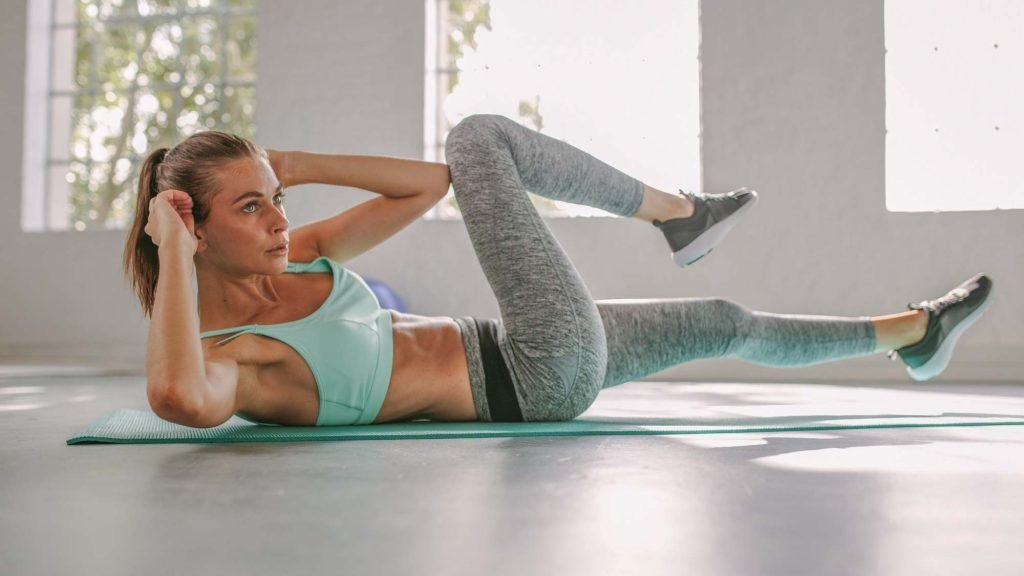
Here’s how to perform bicycle crunches:
- Start by lying flat on your back on a mat or comfortable surface. Place your hands lightly behind your head, elbows pointing out to the sides, and engage your core muscles to lift your shoulders off the ground slightly.
- Lift your legs off the ground, bending your knees to a 90-degree angle. Your shins should be parallel to the ground.
- Begin the movement by straightening your right leg and simultaneously twisting your torso to bring your right elbow towards your left knee.
- At the same time, keep your left knee bent and bring your left elbow towards your right knee, mimicking a cycling motion.
- Continue alternating sides in a smooth, controlled manner, keeping your core engaged throughout the movement.
- Focus on exhaling as you twist and contract your core muscles, and inhaling as you return to the starting position.
- Aim for a slow and controlled pace, avoiding any jerky movements or using momentum to swing your legs.
Common mistakes to avoid when performing bicycle crunches include:
- Pulling on Your Neck: Avoid pulling on your neck with your hands during the movement. Instead, lightly support your head with your fingertips to avoid strain.
- Using Momentum: Focus on using your abdominal muscles to perform the movement rather than relying on momentum. Keep the motion controlled and deliberate.
- Holding Your Breath: Remember to breathe steadily throughout the exercise, exhaling as you twist and inhaling as you return to the starting position.
- Arching Your Back: Keep your lower back pressed into the mat to maintain proper spinal alignment and prevent strain on your lower back.
Bicycle crunches can be modified to suit different fitness levels and goals:
Slow and Controlled: Focus on slow, controlled movements to maximize muscle engagement and intensity.
Tempo Variation: Try changing the tempo of the exercise by slowing down the eccentric (lowering) phase or pausing at the peak contraction for added challenge.
Range of Motion: Adjust the range of motion based on your flexibility and strength level. You can increase the difficulty by extending your legs fully or decrease it by reducing the range of motion.
Frequency: Incorporate bicycle crunches into your core workout routine, aiming for 2-3 sets of 10-20 repetitions, depending on your fitness level.
Incorporating bicycle crunches into your workout routine can help strengthen your core muscles, improve stability, and enhance overall abdominal strength and definition. Whether you’re a beginner looking to build core strength or an advanced athlete aiming to challenge yourself, bicycle crunches are a versatile exercise that can benefit individuals of all fitness levels.
Burpees:
Burpees are a high-intensity, full-body exercise that combines elements of strength training and cardiovascular conditioning. They engage multiple muscle groups, including the chest, shoulders, arms, core, quads, hamstrings, and glutes, making them an effective total-body workout.
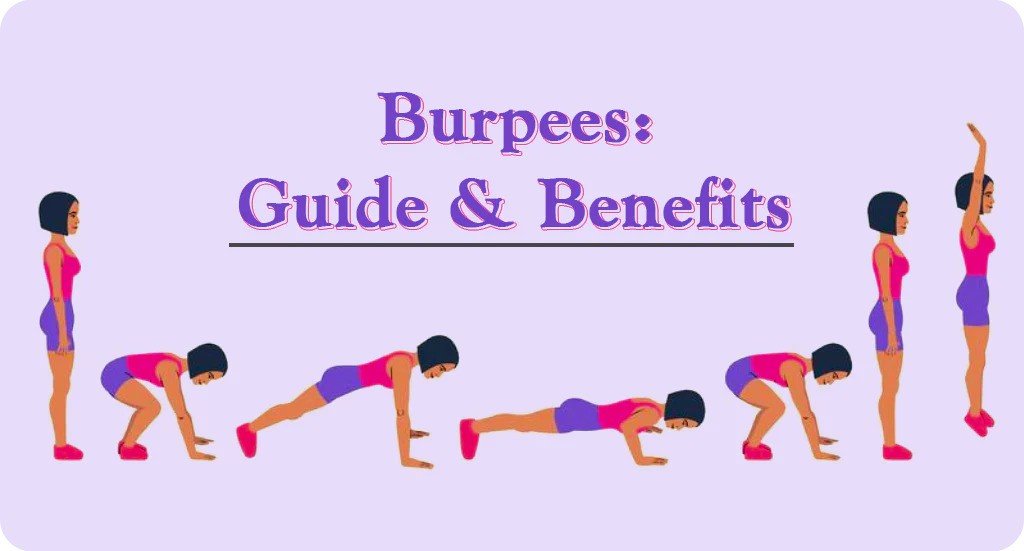
Here’s how to perform a standard burpee:
- Start in a standing position with your feet hip-width apart and your arms at your sides.
- Lower your body into a squat position, bending at the knees and placing your hands on the ground in front of you.
- Kick your feet back into a plank position, keeping your core engaged and your body in a straight line from head to heels.
- Perform a push-up by bending your elbows and lowering your chest towards the ground until your elbows are at a 90-degree angle.
- Push through your palms to extend your arms and return to the plank position.
- Jump your feet back towards your hands, landing softly in the squat position.
- Explosively jump up into the air, reaching your arms overhead.
- Land softly and immediately lower back down into the next repetition, transitioning smoothly from one movement to the next.
Common mistakes to avoid when performing burpees include:
Poor Squat Form: Ensure proper squat form by keeping your chest up, back straight, and knees in line with your toes.
Dropping Hips During the Push-Up: Maintain a straight line from head to heels during the push-up portion, avoiding any sagging or lifting of the hips.
Skipping the Push-Up: Perform a full push-up to maximize the effectiveness of the exercise and engage the muscles of the upper body.
Landing Heavily: Land softly on your feet during the jump portion to reduce impact on your joints and prevent injury.
Burpees can be modified to suit different fitness levels and goals:
Modified Burpees: For beginners or those with limited mobility, omit the push-up portion and step back into the plank position instead of jumping.
Burpee Variations: Add variety to your burpees by incorporating different variations, such as adding a tuck jump at the end, performing a double push-up, or adding a dumbbell or kettlebell for added resistance.
Interval Training: Incorporate burpees into high-intensity interval training (HIIT) workouts by alternating periods of intense exercise, such as burpees, with periods of rest or lower-intensity activity.
Progressive Overload: Increase the intensity of your burpees over time by performing more repetitions, increasing the speed of your movements, or adding additional challenges, such as performing them on an unstable surface or with added weight.
Incorporating burpees into your workout routine can help improve cardiovascular fitness, build strength, and increase endurance. Whether you’re a beginner looking to build foundational fitness or an advanced athlete aiming to push your limits, burpees are a versatile exercise that can be adapted to suit any fitness level.
Conclusion
In conclusion, the 30-minute full body workout presented here offers a convenient and effective way to achieve a comprehensive fitness session in the comfort of your own home. Each exercise targets multiple muscle groups, providing a balanced and efficient workout that can help you build strength, improve endurance, and boost overall fitness levels.
From squats and push-ups to lunges, planks, bicycle crunches, and burpees, this workout engages the major muscle groups of the body, ensuring a total body burn in just 30 minutes. By incorporating both strength and cardiovascular elements, you can maximize calorie burn, increase metabolic rate, and promote muscle growth and toning.
Furthermore, the versatility of these exercises allows for modifications and progressions to suit individual fitness levels and goals. Whether you’re a beginner just starting out on your fitness journey or an experienced athlete looking for a challenging workout, you can adjust the intensity and complexity of each exercise to meet your needs.
Consistency is key when it comes to seeing results, so aim to perform this workout regularly, gradually increasing the intensity and duration as you become stronger and more confident. Remember to listen to your body, prioritize proper form and technique, and always warm up and cool down properly to prevent injury.
Ultimately, by committing to regular exercise and making health and fitness a priority, you can achieve your goals and enjoy the numerous physical and mental benefits that come with a strong, fit, and healthy body. So lace up your sneakers, roll out your mat, and get ready to sweat your way to a stronger, fitter you with this 30-minute full-body workout you can do at home.
